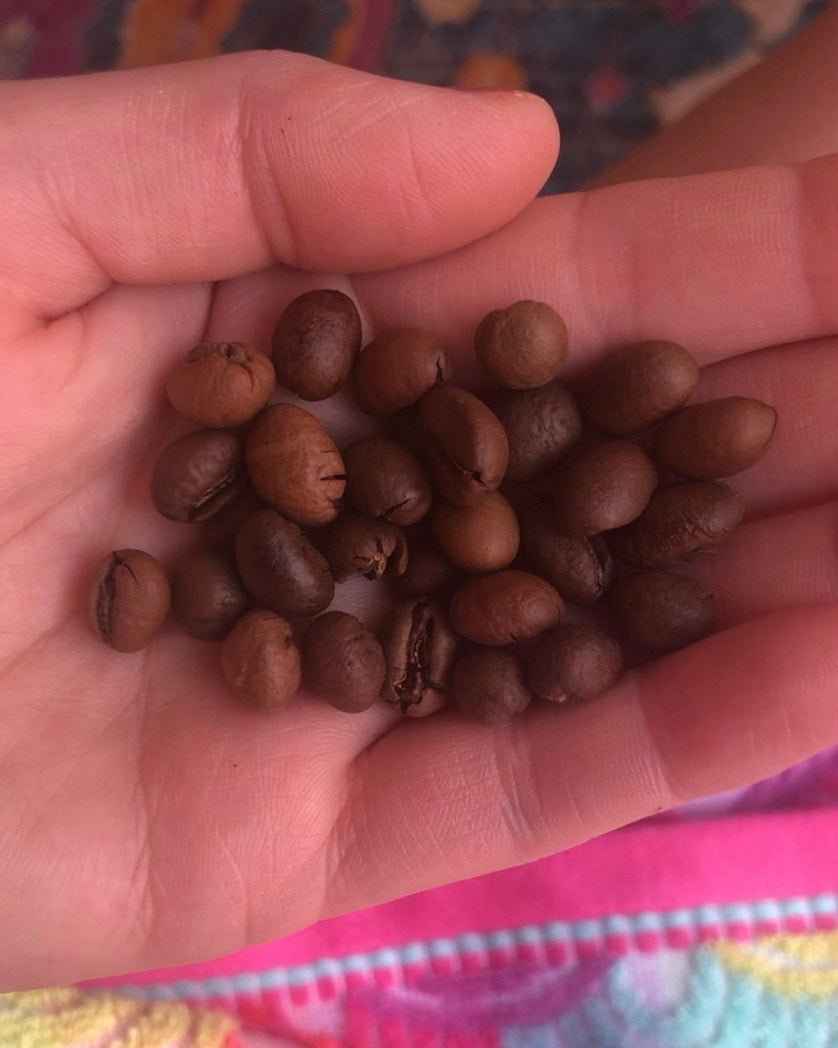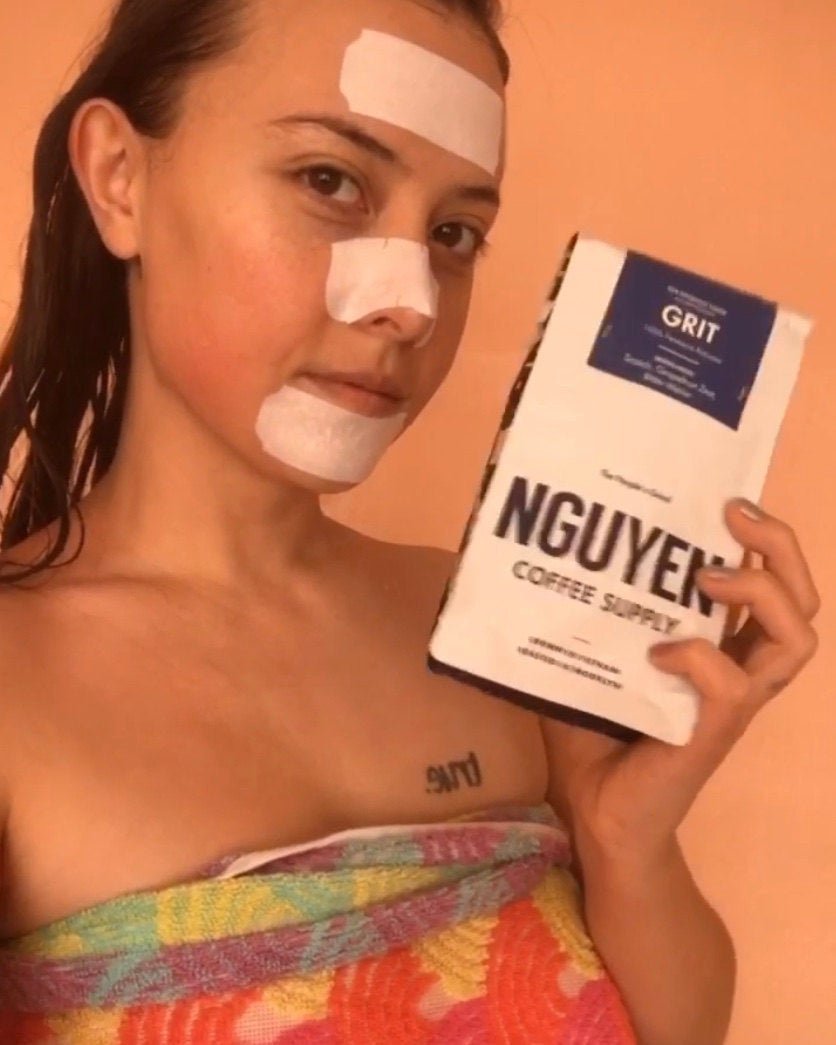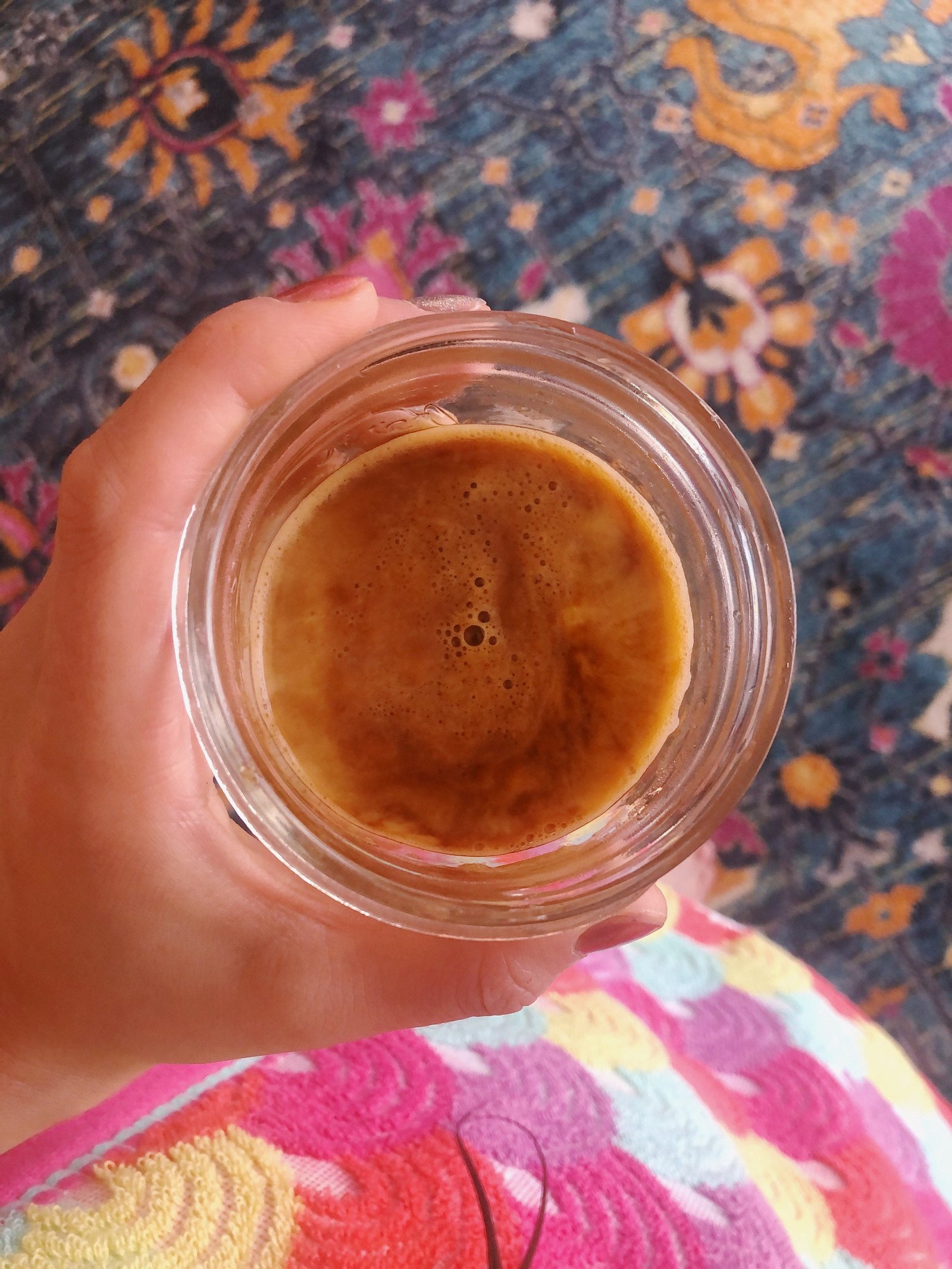

I tried a Vietnamese Robusta peaberry today! Uh also I was wearing a towel and covered in Biore strips, as you can see.
I haven’t had a ton of Robusta in my life but I believe in Robusta as a concept and as a pillar of coffee’s past present and future. Also my friend Will Frith, who owns and operates building.coffee in Ho Chi Minh City, just told me that Robusta is one of Arabica’s parents (Robusta + Eugenoides = Arabica) which I did not know. Will also told me that Robusta has more peaberries than Arabica (around 30% I think?).
Ok but what is a Robusta and what is a peaberry?? some of us may be wondering.
A peaberry is a naturally occuring mutation that results in one coffee seed, not two, growing inside a coffee cherry. (Want to catch up on coffee botanical basics? I wrote a little piece here.) Because there’s only one seed in the cherry, that seed becomes round and not flattened like it would if it had a twin. The round seed is called a peaberry.
If you’re not familiar with Robusta, I’m so happy I get to tell you about it! Robusta is the second-most common species of coffee after Arabica. Its botanical name is Coffea canephora but we call it Robusta because it’s a more hardy (robust) plant. It can grow in low elevation, it’s pest- and disease-resistant, and it produces more coffee per shrub than Arabica.

So anyway I got this Robusta peaberry and I want to tell you about it! But first let’s talk about bitterness real quick.
Robusta can taste all kinds of ways, just like Arabica can taste all kinds of ways, but Robusta will pretty much always be more bitter. The level of bitterness varies – I’ve had Robustas with extremely low bitterness – but it’s just something that tends to come with the territory.
Robusta even has its own cupping sheet bc it’s just a totally different species with a different flavor profile.
The US diet doesn’t contain many bitter foods so a lot of people in the US dislike bitterness. But bitter flavors are much more common in other countries where they are incorporated purposefully – digestifs and aperitifs are an example of this.
In US specialty coffee, bitterness is often treated like the worst possible quality to find in a cup – but I’d like to challenge that!
First, coffee inherently contains bitter flavors. You’ll find some level of bitterness in most cups of coffee.
Second, that bitterness makes coffee more complex, interesting and delicious.
Third, coffees with a lot of bitterness taste DELICIOUS with milk and sugar, full stop.
If you don’t like coffee with milk and sugar that is completely fair, but a lot of people do and there’s literally not one single thing wrong with it. It’s the standard way to consume coffee in many many many countries.
I remember once attending a class on Ethiopian coffee ceremony, where half the class (of white North Americans) refused to drink the coffee with milk, as suggested. Some of them were probably non-dairy drinkers but some actually verbalized that they didn’t believe in drinking coffee with milk. Then they made faces at how the coffee tasted, because they were literally drinking it wrong.
So like, let’s not be a rude pretentious and basically racist asshole like that.
So anyway – I purchased this coffee from Nguyen Coffee Supply, an awesome Brooklyn-based company that sells specialty Arabica and fine Robusta sourced from Da Lat, Vietnam.
In Vietnam Robusta coffee is v popular and it’s a crucial ingredient in phin – strong iced coffee mixed with sweetened condensed milk.
So right away I planned to make a strong coffee and mix it with something sweet and milky.
I used my AeroPress with the Fellow Prismo attachment to make an espresso-style shot. I also wanted to do it this way because Robusta historically was a secret ingredient in Italian espresso blends – in the Olden days I remember people said it boosted crema!
Before adding milk & sugar to my espresso-style shot, I tried a sip of the coffee. It tasted bitter – like omg SO bitter – which again is not a bad thing! The coffee needs to be bitter to provide that punch and complexity in a sweet milk drink. A lot of people also like bitterness on its own.

I didn’t have sweetened condensed milk so I used what I had on hand: a creamy coconut mylk (not like the clear juice inside a coconut – I mean dairy-substitute coconut mylk in a carton) & a generous dallop of agave syrup.
The resulting drink was so delicious I basically chugged it. The balance of bitter, sweet and milky is honestly irresistible to me ESPECIALLY when it’s cold. This drink just would not work with a less bitter coffee. It wouldn’t work with an acidic coffee. It wouldn’t work with any coffee except this Robusta.
After I chugged my iced coconut-agave Robusta cortado, I remembered that Robusta has twice as much caffeine as Arabica. Please send help.
But seriously. If you have never tried a Robusta before, I encourage you to go for it! And keep in mind that Robusta can taste a lot of different ways. I’ve had Robustas w v little bitterness that tasted way better black than with milk.
It’s a little tough to find fine Robustas but I think we’ll be seeing more of them soon. My friend Alexandra Egan at Chromatic Coffee is launching a single origin Robusta in the next month and of course Nguyen Coffee Supply always has a Robusta and a Robusta-Arabica blend.
And as always when trying new coffee things – remember to have fun!
Xo,
Umeko

